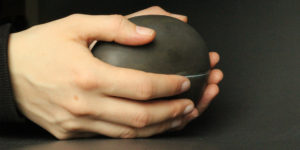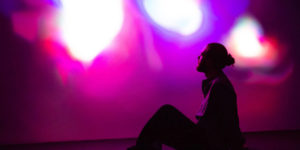Taking Care is an exhibition of twenty works from student members of Hexagram, an interdisciplinary research network for media arts, design, technology and digital culture based in Montreal (Quebec), Canada. Established in 2001, the network brings together 40 faculty and over 200 graduate students from its founding universities, the University of Quebec at Montreal (UQAM) and Concordia University, along with the University of Montreal, McGill and the University of Quebec at Chicoutimi, local and international academic and cultural partners.
The projects exhibited in Taking Care operate at the intersection of ethical-aesthetic concerns. They are not meant to be prescriptive – describing the good life – but rather speculative, asking what the possibilities and conditions of life in the present and future could be. At the same time, they question our understanding of the world as we continually search and struggle to make sense of it. Expressed through a range of forms and media including games, VR, performance, installation, biological art, textiles, sound, video and photography, the projects all involve the use of contemporary technologies, yet their focus lies beyond the technological. From issues of post-colonial conflict to the imperceptible in more than human beings, questions of trace, history, narratives of experience, non-human materiality and representation are assembled and entangled with each other in the spaces of the University of Art and Design and at Ars Electronica venues across Linz. As attention turns to the considerable uncertainty of our future, Taking Care thus examines what is at stake in the ideas and visions of the next generation.

From an open call to Hexagram graduate students across the network, the twenty projects were chosen by a selection committee of Hexagram members and collaborators outside of the university context. The exhibited projects exemplify what is known as “Research-Creation” – a research trend where Hexagram, Quebec and Canada have taken an international lead. This interdisciplinary approach bridges faculty and students from the arts, humanities, social and natural sciences and is well funded and supported by universities, provincial and federal research bodies. Students and faculty from around the world are attracted to Hexagram for its cutting edge research infrastructures – studios, labs, black boxes – and the vibrant cultural scene of Montreal and Quebec, a center for digital arts and culture in North America.
Structured around three research axes (sense, embodiment and movement; materiality; ubiquity), Hexagram responds to the increasing need to develop critical and reflexive theories and methods in artistic practice through experimentation, production, documentation and dissemination. Within Montreal, Hexagram provides an intra-university environment for collaboration through public seminars, events and publications that transcend disciplinary silos and the isolation of university departments. Within Quebec, it also enables structured mobility and exchange between French and English research cultures in art, science, technology and society.


Aseptic Requiem
WhiteFeather Hunter (CA)
Aseptic Requiem presents a new scientific protocol for the compassionate disposal of in vitro semi-living organisms.

Don Federico
Agustina Isidori (IT, AR)
Don Federico is an experimental video installation that juxtaposes YouTube footage of kids playing a hand game and an actual case of femicide.

DRONE
Donna Legault (CA)
DRONE draws on research into the physical dynamics of insect flight and behavior.

Generative Chorus
Marine Theunissen (BE, CA)
The Generative Chorus project is an artistic research laboratory on the chorus in movement.

Microbiome Rebirth Incubator
François-Joseph Lapointe (CA), Marianne Cloutier (CA)
This project symbolically explores the possibility of repairing the microbiome, as a way to re-empower the mother and her child, and to erase the traumatic experience of caesarean birth.

ISLAND
Olivia McGilchrist (FR, JM)
Islands are metaphors for a condensed physical space in which we are aware of the edges of our living environment.

Listener
Suzanne Kite (US)
Listener is a site specific performance artwork that engages with Lakota epistemologies through computational media and narrative.

Maxwell’s Equations
Barbara Layne (US, CA), Lauren Osmond (CA)
Maxwell’s Equations consists of three garments that incorporate unique antenna designs that wirelessly connect the garments to one another.

Feedback Cycles for Oscillographs
Guillaume Arseneault (CA)
Activated by movement on two wheels, this installative action seeks to reveal the unknown between void and short circuit.

Promises
Ida Toft (DK)
Promises explores what local multiplayer games might look like when using algorithmically driven vibration as primary material for expression.

REVOLVE/REVEAL
Louis-Philippe Rondeau (CA)
REVOLVE/REVEAL is an interactive installation based on slit-scan photography, a marginal process which transposes temporality and spatiality within the image.

rustle your leaves to me softly
Jess Marcotte (CA), Dietrich Squinkifer (CA)
In this screenless physical-digital hybrid game, the main interaction is caressing and stroking a plant gently.

Sensum
Alexandre Saunier (FR, QC, CA)
Sensum is an instrument to experiment with the sensory effects of LED light.

SOLA
Agustina Isidori (IT, AR)
SOLA is a video game that embodies the climate of tension, discomfort and fear that can be experienced while walking alone at night in cities where gender-based violence is embedded in everyday life.

to the sooe
Sofian Audry (CA), Erin Gee (CA)
to the sooe re-embodies the cognitive processes and creative voices of three agents into a tangible device

Study 1
Sylvie Chartrand (CA)
The video triptych Study 1 presents three figures performing an asynchronous saltation whose slow motion reveals the successive states of figures’ metamorphosis.

Temporalité Expressive
Marc André Cossette (CA), Axelle Munezero (CA)
Temporalité Expressive examines the relationship between movement and sound on stage.

Un-weaving
Eugenia Reznik (UA, FR, CA)
Un-weaving takes its origin from a linen fabric made by the artist's Ukrainian grandmother in the 1930s, a period of severe famine in Ukraine.

Vitra
Alexandre Saunier (FR, QC, CA)
Vitra is an ensemble of lively light sculptures that modulate the atmosphere of the space.

Of wall to ground
Faye Mullen (CA)
Walls are a vestige of colonization and political instrument since the Anthropocene began; we have never been faced with more walls than we are today.
Credits:
Production Team for Campus: Marine Theunissen, Project coordinator (University of Quebec in Montreal); Alexandre Saunier, Director of production (Concordia University); Patil Tchilinguirian, Exhibition designer (Concordia University); Lorène Chesnel, Head of Communications (University of Montreal); Agustina Isidori, Documentation (Concordia University)
Website: aecampus.hexagram.ca



